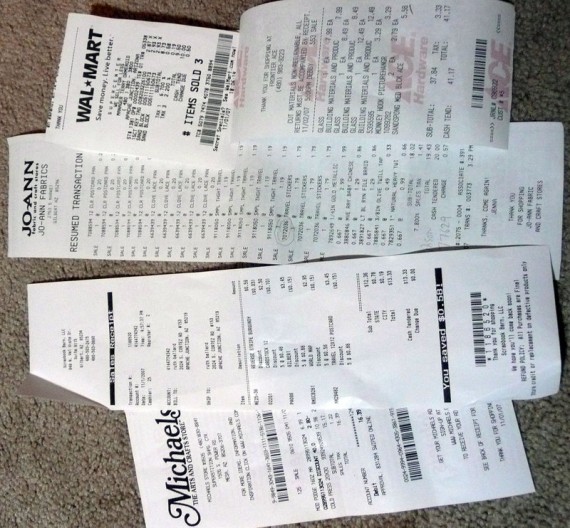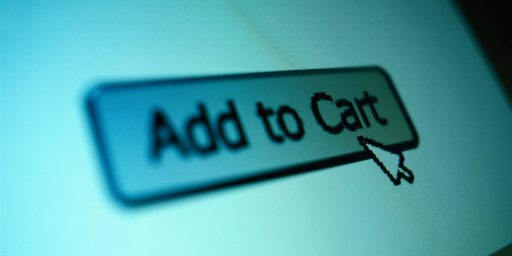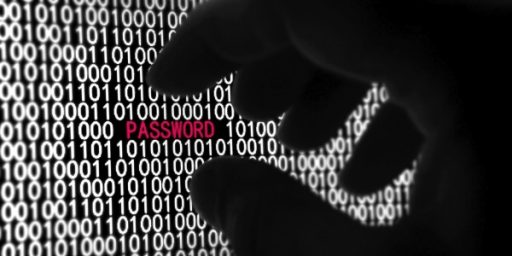Paperless Receipts Coming To A Store Near You
James Joyner’s lament that The Receipt Is Too Damn Long reminded me of an article from The New York Times a few days ago about the rising use of paperless receipts in retail:
At an Old Navy store in Manhattan the other day, Fabienne Michel made a routine purchase of khaki shorts. But she left the store without something equally routine: her receipt.
The sales clerk had sent it to Ms. Michel by e-mail. “It’s easier,” said Ms. Michel, a 30-year-old nurse. “You can reprint it, save it, make folders in your e-mail.”
To the rubbish pile that the Internet is creating, alongside the road maps, newspapers and music CDs, add one more artifact of consumer life, the paper receipt.
Major retailers, including Whole Foods Market, Nordstrom, Gap Inc. (which owns Old Navy and Banana Republic), Anthropologie, Patagonia, Sears and Kmart, have begun offering electronic versions of receipts, either e-mailed or uploaded to password-protected Web sites. And more and more customers, the retailers report, are opting for paperless.
“As consumers, we’re changing the way we shop,” said Jennifer Miles, who oversees retail systems at VeriFone, which makes checkout technology. “Customers are starting to want electronic receipts.”
Many people like keeping searchable records on a computer — e-receipts come in handy during tax season, make some returns a snap and are a tidy addition to the e-purchases already stored on countless hard drives. Others see the paper versions as an anachronism, wasteful of resources and as irrelevant as printed bank statements and mutual fund reports.
And face it, paper receipts can be annoyances, burrowing into the bottoms of purses, getting lost in glove compartments or fattening up wallets — only to be pulled out and puzzled over long after their usefulness has expired.
“I throw them out,” said Francesca Joseph, 29, who was shopping with Ms. Michel at the Old Navy store.
Of course, many people are likely to object to handing out their email address to retailers just to get a receipt given the fact that it’s likely to lead to a load of solicitations and “special officers” in the future, which is why some companies are looking for alternatives:
Ms. Sock’s service, MyReceipts, tries to sidestep e-mail objections by offering other electronic delivery options. The company is working with retailers like Whole Foods to upload purchase information to a password-protected site. Customers can search their receipts and soon, Ms. Sock said, review tallies of how much they spend on ice cream or shampoo.
All that data helps the retailers, too, who can send customers coupons based on the purchases history. Ms. Sock said retailers would see only a customer ID number, not personal information, unless the shopper elected to share personal information.
Another obvious option is to tie the receipt to the ubiquitous consumer loyalty cards that grocery stores and other retailers hand out to customers. One local supermarket her in Northern Virginia allows customers who have made purchases tied to their loyalty card to view receipts on a password-protected internet site. Yes, there are special offers available online based on what you’ve purchased, but that doesn’t strike me as too big an invasion of privacy given the discounts and convenience involved.
Given that paper receipts are increasingly becoming an annoyance, this seems like a promising avenue of technology.







Are you referring to Wegman’s here? If so, I’ll gloss over the quibble that it’s a multi-regional chain and add that I commend them on how they manage your receipts, if you’ve got their loyalty card, of course.
But to walk out of a store with an expensive purchase in hand without a receipt also in hand? I don’t think much of that idea. Email is very reliable, but not anywhere near 100%, and even Wegman’s approach doesn’t have the receipt up on their web site until at least later in the day.
I want to have that receipt in my possession before I leave the store, and the credit card record is insufficient for that purpose, at least as it currently exists. If I can confirm that I have the electronic receipt, then fine. But failing that, give me that slip of paper.
I will add that I give out my real e-mail address to as few places as possible as a means of reducing the amount of places personal info about me is stored. Not merely do I not want the spam, but it helps prevent identity theft.
I only use paper ones nowadays for expense reports.
Once again Apple is way ahead of the curve, their stores have been doing this for years.
Wells Fargo now offers this option at their ATM — you can have an electronic receipt sent either to your email or you WF account page.
Even better, create an email address that is expendable and give that to the retailer. In other words, an email address you don’t mind giving out and not worried about it becoming a spam magnet. The email address you use for work or personal communication remain (relatively…hopefully) spam-free.
On the other hand, having a printed receipt for when that over-zealous store security officer demands you assume the position, you can quickly show the receipt to calm the budding junior Buford Pusser down.